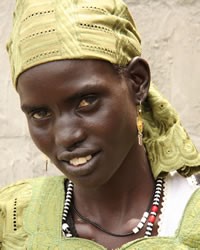Dinka, Southeastern in South Sudan

Photo Source:
Brett Michael Innes
|
Send Joshua Project a map of this people group.
|
| People Name: | Dinka, Southeastern |
| Country: | South Sudan |
| 10/40 Window: | No |
| Population: | 912,000 |
| World Population: | 924,000 |
| Primary Language: | Dinka, Southeastern |
| Primary Religion: | Christianity |
| Christian Adherents: | 75.00 % |
| Evangelicals: | 18.00 % |
| Scripture: | New Testament |
| Ministry Resources: | Yes |
| Jesus Film: | No |
| Audio Recordings: | Yes |
| People Cluster: | Nilotic |
| Affinity Bloc: | Sub-Saharan Peoples |
| Progress Level: |
|
Introduction / History
The Southeastern Dinka, also known as the Bor Dinka, speak a dialect of the Dinka language called Dinka, Southeastern (ISO 639-3: dks). This dialect is part of the Nilotic language family, specifically the Eastern Sudanic branch of the Nilo-Saharan languages. The Dinka language is tonal and features a complex vowel system with distinctions in phonation and length.Historically, the Dinka are agro-pastoralists who have lived along the Nile basin for centuries. Their society is organized into clans and subgroups, with the Southeastern Dinka primarily residing in Bor South and Twic East counties of Jonglei State. Their history includes migration, conflict, and resilience through civil wars and environmental challenges.
What Are Their Lives Like?
The Southeastern Dinka live in rural communities where cattle herding is central to their economy, culture, and social structure. Cattle are used for dowries, food, and as a symbol of wealth. Alongside herding, they practice subsistence farming, growing crops like sorghum, millet, and maize during the rainy season.Their homes are typically mud huts with thatched roofs, arranged in family compounds. Life is communal, and social roles are deeply tied to age and gender. Seasonal migration for grazing and farming is common, and traditional ceremonies mark life transitions such as initiation into adulthood.
What Are Their Beliefs?
Traditionally, the Southeastern Dinka practice animism, with a belief system centered around Nhialic, the supreme creator god who is distant from daily human affairs. They also recognize a pantheon of deities.Spiritual practices include sacrifices, prayers, and totem veneration. Totems are inherited from both parents and may be animals or natural elements. These are not worshipped but are respected as spiritual relatives. Some Southeastern Dinka have converted to Christianity, with 75% identifying as Christian, though only 18% are evangelical believers.
What Are Their Needs?
Access to clean water is limited, especially during dry seasons and floods. Healthcare services are scarce, with only 44% of the population living near functioning health facilities. Malaria and cholera are widespread. Food insecurity is increasing due to climate-related shocks, such as floods and droughts, which disrupt agriculture and cattle grazing.Education is underdeveloped, particularly for girls, who often leave school early due to cultural expectations and early marriage. Infrastructure is weak, and many communities are isolated, making it difficult to deliver aid and services.Conflict and displacement continue to affect the region, with intercommunal violence and the influx of returnees from Sudan straining local resources.
Prayer Points
Pray for spiritual awakening among the Southeastern Dinka, that they may encounter the love and truth of Christ and share it with others.Pray for local Christian leaders to rise up and disciple others with wisdom and cultural sensitivity.Pray for peace and reconciliation in areas affected by intercommunal violence and cattle raiding.Pray for educational opportunities, especially for girls, and for cultural shifts that support their growth.Pray for healing and provision for those suffering from disease, displacement, and trauma.Pray for sustainable development, including clean water, healthcare, and agricultural resilience.